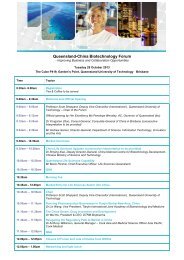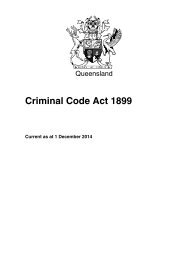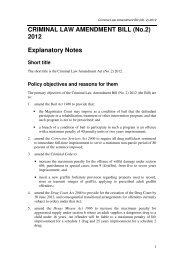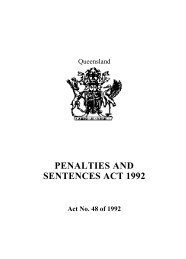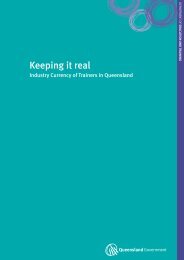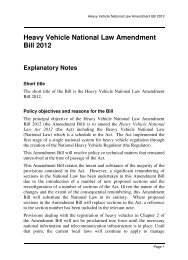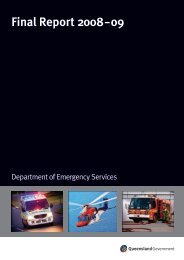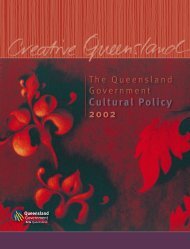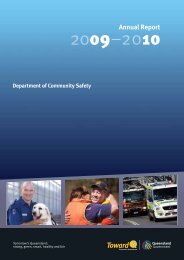Queensland Life Sciences Industry Report 2012 (PDF, 3.5MB)
Queensland Life Sciences Industry Report 2012 (PDF, 3.5MB)
Queensland Life Sciences Industry Report 2012 (PDF, 3.5MB)
Create successful ePaper yourself
Turn your PDF publications into a flip-book with our unique Google optimized e-Paper software.
Figure 33: Number of patent applications originating in<br />
Australia, 1995–2010<br />
has not been evident in subsequent years (Figure 34). 109 Across<br />
OECD countries, Australia accounted for 1.5% of pharmaceutical<br />
patents filed under the PCT, 2007-09.<br />
The World Intellectual Property Organisation reported that<br />
resident patent filings by Australian inventors were 4.13 patents<br />
per $b GDP in 2006 and 3.33 in 2009 (last available year). 110 The<br />
resident patent filings by Australian inventors per US$m of R&D<br />
expenditure has declined 47% over the past nine years, from 0.51<br />
in 2001 to 0.24 in 2009 (Figure 35). 111 This is considered a measure<br />
of patent productivity and the decline may be the consequence<br />
of a number of factors; including the increased cost of R&D<br />
activities and patent protection leading to more focused patenting<br />
strategies. A similar decline occurred in the UK. Filings in Canada<br />
were 26% higher in 2009 than they were in 2001, and the figure for<br />
the US was 3.6% over the same period (Figure 35). 112<br />
Figure 34: Number of patent applications by specific<br />
technology area originating in Australia, 2002–2009<br />
Figure 35: Number of patents filed per US$m R&D expenditure,<br />
2001–2009<br />
Granted patents provide a period of protection from others<br />
infringing the claimed invention. This enables time to<br />
commercialise the invention and a period of market exclusivity.<br />
Granted patents, particularly those in US, EU or Japan, are often<br />
seen as indicators of success in the <strong>Life</strong> <strong>Sciences</strong> <strong>Industry</strong> and<br />
are often critical in demonstrating value to potential partners<br />
or investors.<br />
The US is the largest and most lucrative pharmaceutical and<br />
healthcare market in the world and Australian organisations<br />
typically seek to file patents in the US since it is a key market for<br />
potential products and partnerships. Figure 36 shows the total<br />
number of US <strong>Life</strong> <strong>Sciences</strong> patents and patent applications<br />
granted and applied for by Australian individuals and organisations<br />
(as determined by the residence of the first-named inventor),<br />
each year between 2007 and 2011. The data is for three relevant<br />
technology classes, (1) drug, bio-affecting and body treating<br />
compositions, (2) molecular biology and microbiology chemistry<br />
and (3) analytical and immunological testing. 113<br />
Figure 36: US <strong>Life</strong> <strong>Sciences</strong> patents and patent applications;<br />
Australian organisations/individuals, 2007–2011 114<br />
10.3.1 Patents and License Agreements<br />
In the current survey, a total of 272 patent applications were<br />
reported as filed or granted by 28 respondents (213 for 21<br />
companies and 59 for seven research organisations). In<br />
comparison, 143 patents and patent applications were granted and<br />
filed by 38 companies in 2009. The average number of patents filed<br />
or granted in 2011 was 9.7 and the median was 2.0. Biotechnology<br />
organisations reported 88% of filed or granted patents and those<br />
in TMD accounted for the remaining 12%.<br />
83 out-license agreements were negotiated by 12 organisations<br />
in 2011, with one company accounting for 60 of those agreements.<br />
97.6% of out-license agreements were achieved by Biotechnology<br />
organisations and 2.4% by TMD companies (data not shown).<br />
Ten organisations nominated a combined value of $9.2 million<br />
(average $0.9 million) for their out-license agreements (data<br />
not shown).<br />
A comparison of the number of out-license agreements reported<br />
by Biotechnology organisations through the past four surveys is<br />
shown in Table 58. The number of agreements per respondent has<br />
been increasing.<br />
109 Source: WIPO Statistics Database, December 2011<br />
110 World Intellectual Property Organisation, World Intellectual Property Indicators, 2011,<br />
111 Ibid.<br />
112 Ibid.<br />
113 US Patent and Trademark Office, ‘Patenting in Technology Classes — Breakout By Geographic Origin, 2011, http://www.uspto.gov<br />
114 US Patent and Trademark Office, ‘Patenting in Technology Classes — Breakout By Geographic Origin, 2011, http://www.uspto.gov<br />
67



